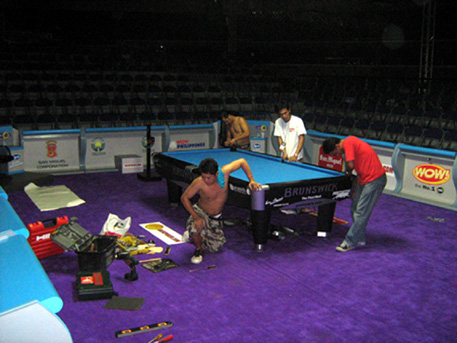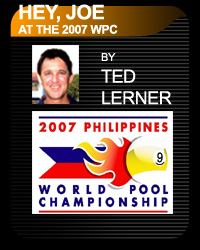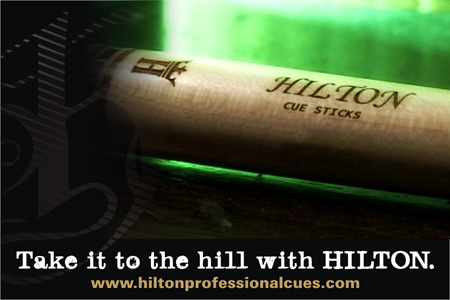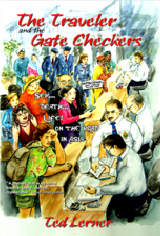Araneta Coliseum
Quezon City
Metro Manila
Philippines
www.matchroomsport.com
www.hey-joe.net
www.tedlerner.com
www.hiltonprofessionalcues.com
3-11 November 2007
CREATING ANOTHER THRILLA
The inside story of how pool officials have tried to save the 2007 World Pool Championship from the plague of soft breaks, just in time for Sunday’s finale.
By Ted Lerner

Manila, Philippines -- At just about 10:30 pm this past Friday, Johan Ruijsink, the Dutch national pool coach and coach of the European Mosconi Cup team was walking up and down the concourse of the Araneta Coliseum looking for Roberto Gomez. It was about an hour before the start of Gomez’ round of 16 match against Ruijsink’s player Niels Feijen, which was to take place on the main TV table.
Why, you may ask, would the coach of Feijen want to speak with Gomez? Well, Ruijsink had a plan. He was sick of the soft break, which everyone, especially Gomez, was using with major success on table one. He felt it was making the game way too predictable, repetitive and terminally boring.
“This kind of pool is no good,” Ruijsink said. “It’s not good for the game. If this was the way the game was played when I first discovered pool, I would have never taken up the sport. I would have played chess instead. It’s boring.”
"Read More..." for the details.
But, of course, Ruijsink had other, more immediate motives than acting as a savior to the sport of 9-ball. He, like millions of others, saw Gomez employ the powder puff break to perfection the previous two nights on the same TV table, first blowing out fellow Dutchman Alex Lely 10-1, then destroying Taiwan’s Chao Fong Pang 10-2. And so he wanted to track down Gomez and offer him a deal.
“We want him to break hard,” Ruijsink said. “We both agree to break the balls hard. Enough of this soft break. Yes he can run 11 racks. But so can Niels. Niels is a tactician and he can do the same thing. I don’t think he wants that as well. So to avoid this we want to make a deal with him.”
 Ruijsink hurried off to look for Gomez. Although I knew Gomez would never accept such a proposition, from a fan’s perspective, it sounded like a decent idea. I, like nearly everyone else who loves 9-ball, am completely sick of the soft break. The players, even the ones using the soft break to their advantage, hate the soft break. I haven’t yet found a person out there who thinks it’s good for the game. Everyone, from officials administering the sport, to the players who compete, to the fans who watch and buy the tickets, all realize the soft break is ruining the game. We all want to see the spectacle of the rack smashed to pieces. We all want to see different layouts and varied plays on each rack.
Ruijsink hurried off to look for Gomez. Although I knew Gomez would never accept such a proposition, from a fan’s perspective, it sounded like a decent idea. I, like nearly everyone else who loves 9-ball, am completely sick of the soft break. The players, even the ones using the soft break to their advantage, hate the soft break. I haven’t yet found a person out there who thinks it’s good for the game. Everyone, from officials administering the sport, to the players who compete, to the fans who watch and buy the tickets, all realize the soft break is ruining the game. We all want to see the spectacle of the rack smashed to pieces. We all want to see different layouts and varied plays on each rack. 40 minutes later, down in the tunnel behind the main TV table, Thomas Overbeck, the Vice President and Sports Director of the World Pool Association, the world governing body of pool, was striding hurriedly towards the arena. He was looking for Ralf Souquet, hoping to get the great German champion’s opinions on this very subject. In fact Overbeck has been speaking with lots of players this week about the soft break plague in 9-ball. He is well aware of the controversy and has been for the last seven years, ever since Mika Immonen discovered it in 2001 and rode it all the way to the World Championship. But with the calls from all sectors getting louder every year, Overbeck was hoping to finally resolve it with finality. And soon.
“I’m trying to talk to as many people as I can. I don’t think we want to make a hasty decision,” Overbeck said. “We are investigating what to do. Definitely we want to get rid of the soft break. We have to find out what’s the best way. We want to bring back the hard break. The question is, how do you bring back the power break, and the skill shot, which is the control of the cue ball on the hard break.”
Overbeck explained that the WPA has and still is taking suggestions from all sectors on how to send the soft break into oblivion. There seems to be a certain urgency now because the clamor from all sectors is louder than ever. But the search for a cure has not been easy.
“We are looking at everything,” he said. “The material cut of the pocket. The shape of the rack, the cloth, the way we rack the balls, where we rack the balls, putting an added ball in the rack and then taking it away after the break. We came up with tapping of the balls, three balls have to go into the kitchen(behind the head string). We’ve been trying things. The problem is they(the players) always find a way around it.”
Of course, the best pool players in the world will always try and find a solution to the 9-ball puzzle, a legal route around complexities of the game. If you racked the balls and hung them from a chandelier, these pool wizards would soon find a way to break them with ease. That’s why Overbeck is particularly keen on seeking these guys’ opinions.
Overbeck’s been having conversations this week with players such as Johnny Archer, Thorsten Hohmann. Clearly the winner’s breaks format is here to stay, as nearly everyone is in agreement that this is the most exciting, fan friendly format out there. The problem is, with today’s tables, the soft break allows the wing ball to always drop in, while leaving good position on the one ball. And, of course, the spread of the balls looks the same every break, and, thus, the game becomes predictable and boring.
The idea of course is to have the best of both worlds. The excitement of winner’s breaks, where you see players run racks, make great comebacks, but not where the racks are all the same. Fans want to see variety, great skill shots, not the same thing all the time. Most of all fans, and everyone else, want to bring back the spectacular power break.
One idea that seems to be taking hold is to target the cloth. The Simonis cloth that is used in most tournament play always comes pre-washed. This makes the cloth slick and subsequently makes the pockets seem extra wide.
“A major part of the problem seems to be the cloth,” Overbeck said. “We should talk to the cloth manufacturers and see what they can do. Maybe they can treat the cloth somehow to stop it from being so slick.” Whatever he comes up with, Overbeck was clearly intent on finding a satisfactory result soon.
“I’m trying to find a solution,” he said. “I don’t know if I will find the stone of wisdom. I’m talking to the players, talking to the people in the industry. You have to walk a thin line. You have to gauge what the fans want, but you also have to gauge needs of TV. Then there are the sporting aspects. If you ask the players what would be fair, they’d say make it a race to 31, but TV can’t sell that.
“I’m intent on solving this issue in the next few weeks. I don’t know if I can. I’m on a mission, but it may be mission impossible.”
**
Ruijsink eventually did find Gomez that night and offered him the deal. Gomez, as everyone who saw the match with Feijen can readily conclude, turned down the offer of both players breaking hard, and soft broke his way to an 11-0 destruction of the Dutch great.
It’s been like that for every player competing on the main TV table at the Araneta. Yesterday,(Saturday) Gomez went on to destroy Taiwan’s Kuo Puo Cheng on the same TV table one in the quarterfinals, 11-4, again employing the soft break to perfection. At the same time, England’s Daryl Peach and the Filipino great Francisco Bustamante, rode the soft break on the same TV table to lopsided victories. When the two played on that same TV table in the semi-finals, both players employed the soft break. Peach eked out a thrilling 11-10 victory to move into the finals today.
While Filipinos were unanimous in cheering their compatriots success, loud murmurs were rising throughout the arena, in people’s homes, and especially on the Internet. The soft break is boring, it’s sissy pool, it’s the perfect antidote for insomnia.
Officials like Overbeck have been paying close attention. One of the most often asked questions here at the World Pool Championships is why is it that only TV table one is breaking with such ease. All the other seven tables have been playing much more difficult, and players have been breaking hard. Then just about Friday, the preliminary conclusion among officials here became this: TV table one was breaking so easy and soft because of the very strong TV lights overhead were perhaps drying out the table cloth to such an extent that it made the cloth dry and thus fast.
I have been doing TV commentary on Table 2 all week, and noticed that the soft break was not working. Players on this table were all breaking hard. The one ball was dropping, but at least the balls would be spread out in varying layouts, offering much more interesting patterns, and thus, much more interesting pool. This was the case when Roberto Gomez finally took his act over to Table 2 on Saturday for his semi-final showdown with England’s Karl Boyes. Boyes had been breaking hard in his quarterfinal match there against Joven Bustamante and had great success, winning 11-8. Gomez followed suit, abandoning the soft break and slamming the cue ball into the pack. He soon found the proper speed and continued to break hard the entire match. Combined with some stunning potting and creativity, which led to a an 11-4 victory, I can honestly say it was one of the most enjoyable matches of professional pool I’ve watched in a long time.
By Saturday evening, everyone involved in organizing the World Pool Championship was in agreement that something had to be done to avoid a Sunday final in which both players broke soft on Table 1, thus producing what was sure to be a snoozer of a final. Obviously they could not institute a last minute rule, like ordering both players to break hard, because that would be contrived and unfair. But what to do to?
Just after Saturday’s semi-final matches, Yen Makabenta, the president of Raya Sports, and the man responsible for bringing the World Pool Championship to the Philippines two years running now, went to see Overbeck and Matchroom officials. He didn’t want his dream final to be a soft break bore fest. So he offered this idea; since TV Table 2 was playing ideal, why not move that table over to the main arena overnight for Sunday’s final match.
This sounded at first like a good idea, but, of course, there was a catch. It turns out that the lights over TV Table 2 are not as strong as on table one. And so if the main reason for the fast cloth on Table 1 was the strong lights, then that meant that if you moved table two over to the main arena for the final, the strong lights there would quickly produce conditions making the newly placed table into a lightning quick surface conducive to soft breaking. And thus there was no guarantee of preventing a soft break marathon.
And so the final conclusion to try and ensure a thrilling and fun final on Sunday at the World Pool Championship came down on Saturday evening, after the fans and most players had already left the arena. The better breaking TV Table 2 would be moved to the main arena overnight. Then, the conditions in the arena would be adjusted to make the cloth less slick. The air conditioning in the Araneta would be turned off immediately and left off overnight and up until as long as reasonably possible for the Sunday final. This would add moisture into the air and might help slow down the cloth. In addition, to stop the cloth from drying, the strong TV lights on Table 1 would be kept off until the last possible moment on Sunday when the worldwide broadcast would begin.
Matchroom officials informed both Roberto Gomez and Daryl Peach of these moves, and both players, even though they had used the soft break with great success on Table 1 with great success, had no complaints.
Of course there is no guarantee that these moves will work. But everyone, from fans, to officials, to the players, is in agreement that the sport of pool needs a final as exciting and captivating as what Ali and Frazier created in the very same venue 32 years ago. The soft break could never produce another Thrilla in Manila. The hard break can. The solution to pool’s plague may have been found just in time.
**

www.hiltonprofessionalcues.com
I’d like to welcome aboard Hilton Cues as a sponsor of this column. Some of you who have been able to make it to the Araneta Coliseum for the World Pool Championship may have seen the team from Hilton Cues at their booth in the lobby.
If you have not been able to make it here, then check out the Hilton Cues website at www.hiltonprofessionalcues.com. Hilton has already lined up a couple of big name pros to use their products. They obviously know what they are doing as they have come aboard to support my ranting. Cheers to Hilton Cues!
----------------------------------------------------------------------------------------------


Email Ted at ted@hey-joe.net.
Or visit his website at www.hey-joe.net or www.tedlerner.com